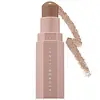What's inside
What's inside
 Key Ingredients
Key Ingredients

 Benefits
Benefits

 Concerns
Concerns

 Ingredients Side-by-side
Ingredients Side-by-side

Hydrogenated Polybutene
Polyhydroxystearic Acid
EmulsifyingRicinus Communis Seed Oil
MaskingHelianthus Annuus Seed Wax
Skin ConditioningDiisostearyl Malate
EmollientTriisostearyl Citrate
EmollientMicrocrystalline Wax
Emulsion StabilisingSilica
AbrasiveZea Mays Starch
AbsorbentJojoba Esters
EmollientButyrospermum Parkii Butter
Skin ConditioningOryza Sativa Bran Extract
Skin ConditioningMica
Cosmetic ColorantMangifera Indica Seed Butter
Skin ConditioningPrunus Avium Seed Oil
EmollientRosa Canina Seed Oil
EmollientCaprylyl Glycol
EmollientEthylhexylglycerin
Skin ConditioningCarthamus Tinctorius Seed Oil
MaskingHelianthus Annuus Extract
EmollientAcacia Decurrens Flower Wax
EmollientPolyglycerin-3
HumectantRosmarinus Officinalis Leaf Extract
AntimicrobialTocopherol
AntioxidantCamellia Sinensis Leaf Extract
AntimicrobialChamomilla Recutita Flower Extract
MaskingTocopheryl Acetate
AntioxidantCI 77891
Cosmetic ColorantIron Oxides
Hydrogenated Polybutene, Polyhydroxystearic Acid, Ricinus Communis Seed Oil, Helianthus Annuus Seed Wax, Diisostearyl Malate, Triisostearyl Citrate, Microcrystalline Wax, Silica, Zea Mays Starch, Jojoba Esters, Butyrospermum Parkii Butter, Oryza Sativa Bran Extract, Mica, Mangifera Indica Seed Butter, Prunus Avium Seed Oil, Rosa Canina Seed Oil, Caprylyl Glycol, Ethylhexylglycerin, Carthamus Tinctorius Seed Oil, Helianthus Annuus Extract, Acacia Decurrens Flower Wax, Polyglycerin-3, Rosmarinus Officinalis Leaf Extract, Tocopherol, Camellia Sinensis Leaf Extract, Chamomilla Recutita Flower Extract, Tocopheryl Acetate, CI 77891, Iron Oxides
Tricaprylin
MaskingC12-15 Alkyl Ethylhexanoate
EmollientPolyethylene
AbrasivePolymethyl Methacrylate
Octyldodecanol
EmollientSucrose Acetate Isobutyrate
Mica
Cosmetic ColorantCera Microcristallina
Emulsion StabilisingOctyldodecyl Neopentanoate
EmollientSilica
AbrasivePolymethylsilsesquioxane
Caprylyl Glycol
EmollientCetyl PEG/PPG-10/1 Dimethicone
EmulsifyingVp/Eicosene Copolymer
Vp/Hexadecene Copolymer
Cocos Nucifera Oil
MaskingPentaerythrityl Tetra-Di-T-Butyl Hydroxyhydrocinnamate
AntioxidantTocopheryl Acetate
AntioxidantAscorbyl Palmitate
AntioxidantSodium Hyaluronate
HumectantTocopherol
AntioxidantCalcium Sodium Borosilicate
Synthetic Fluorphlogopite
Calcium Aluminum Borosilicate
Polyethylene Terephthalate
Acrylates Copolymer
Tin Oxide
AbrasiveTitanium Dioxide
Cosmetic ColorantIron Oxides
CI 15985
Cosmetic ColorantCI 19140
Cosmetic ColorantBHT
AntioxidantCI 77891
Cosmetic ColorantTricaprylin, C12-15 Alkyl Ethylhexanoate, Polyethylene, Polymethyl Methacrylate, Octyldodecanol, Sucrose Acetate Isobutyrate, Mica, Cera Microcristallina, Octyldodecyl Neopentanoate, Silica, Polymethylsilsesquioxane, Caprylyl Glycol, Cetyl PEG/PPG-10/1 Dimethicone, Vp/Eicosene Copolymer, Vp/Hexadecene Copolymer, Cocos Nucifera Oil, Pentaerythrityl Tetra-Di-T-Butyl Hydroxyhydrocinnamate, Tocopheryl Acetate, Ascorbyl Palmitate, Sodium Hyaluronate, Tocopherol, Calcium Sodium Borosilicate, Synthetic Fluorphlogopite, Calcium Aluminum Borosilicate, Polyethylene Terephthalate, Acrylates Copolymer, Tin Oxide, Titanium Dioxide, Iron Oxides, CI 15985, CI 19140, BHT, CI 77891
 Reviews
Reviews

Ingredients Explained
These ingredients are found in both products.
Ingredients higher up in an ingredient list are typically present in a larger amount.
Caprylyl Glycol is a humectant and emollient, meaning it attracts and preserves moisture.
It is a common ingredient in many products, especially those designed to hydrate skin. The primary benefits are retaining moisture, skin softening, and promoting a healthy skin barrier.
Though Caprylyl Glycol is an alcohol derived from fatty acids, it is not the kind that can dry out skin.
This ingredient is also used as a preservative to extend the life of products. It has slight antimicrobial properties.
Learn more about Caprylyl GlycolCi 77891 is a white pigment from Titanium dioxide. It is naturally found in minerals such as rutile and ilmenite.
It's main function is to add a white color to cosmetics. It can also be mixed with other colors to create different shades.
Ci 77891 is commonly found in sunscreens due to its ability to block UV rays.
Learn more about CI 77891Mica is a naturally occurring mineral used to add shimmer and color in cosmetics. It can also help improve the texture of a product or give it an opaque, white/silver color.
Serecite is the name for very fine but ragged grains of mica.
This ingredient is often coated with metal oxides like titanium dioxide. Trace amounts of heavy metals may be found in mica, but these metals are not harmful in our personal products.
Mica has been used since prehistoric times throughout the world. Ancient Egyptian, Indian, Greek, Roman, Aztec, and Chinese civilizations have used mica.
Learn more about MicaSilica, also known as silicon dioxide, is a naturally occurring mineral. It is used as a fine, spherical, and porous powder in cosmetics.
Though it has exfoliant properties, the function of silica varies depending on the product.
The unique structure of silica enhances the spreadability and adds smoothness, making it a great texture enhancer.
It is also used as an active carrier, emulsifier, and mattifier due to its ability to absorb excess oil.
In some products, tiny microneedles called spicules are made from silica or hydrolyzed sponge. When you rub them in, they lightly polish away dead skin layers and enhance the penetration of active ingredients.
Learn more about SilicaTocopherol (also known as Vitamin E) is a common antioxidant used to help protect the skin from free-radicals and strengthen the skin barrier. It's also fat soluble - this means our skin is great at absorbing it.
Vitamin E also helps keep your natural skin lipids healthy. Your lipid skin barrier naturally consists of lipids, ceramides, and fatty acids. Vitamin E offers extra protection for your skin’s lipid barrier, keeping your skin healthy and nourished.
Another benefit is a bit of UV protection. Vitamin E helps reduce the damage caused by UVB rays. (It should not replace your sunscreen). Combining it with Vitamin C can decrease sunburned cells and hyperpigmentation after UV exposure.
You might have noticed Vitamin E + C often paired together. This is because it is great at stabilizing Vitamin C. Using the two together helps increase the effectiveness of both ingredients.
There are often claims that Vitamin E can reduce/prevent scarring, but these claims haven't been confirmed by scientific research.
Learn more about TocopherolTocopheryl Acetate is AKA Vitamin E. It is an antioxidant and protects your skin from free radicals. Free radicals damage the skin by breaking down collagen.
One study found using Tocopheryl Acetate with Vitamin C decreased the number of sunburned cells.
Tocopheryl Acetate is commonly found in both skincare and dietary supplements.
Learn more about Tocopheryl AcetateThis ingredient is a combination of red, black, and yellow iron oxide pigments. This combination of colors is usually found in foundation, because it results in a "skin" color.